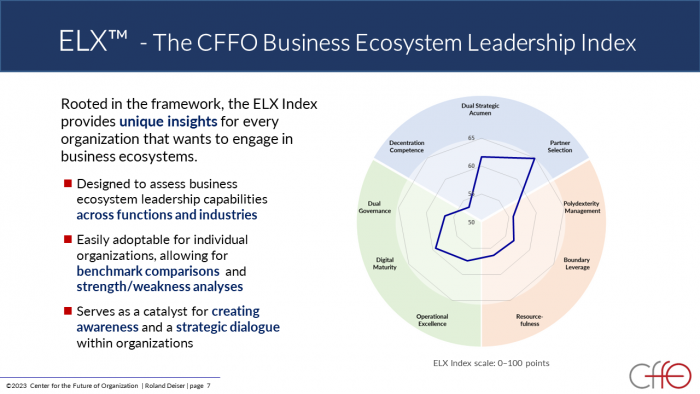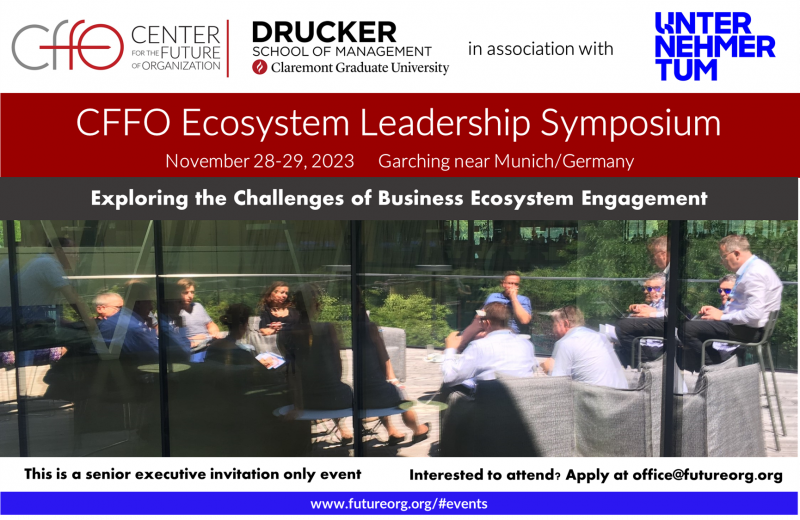
As an ecosystem player, you must strategize on two concurrent levels – your own organization, and the meta-organization of the shared ecosystem.
Successful business ecosystems are based on a compelling value proposition that is based on a unique combination of contributions from multiple partners. Just like with any business, this requires a strategic vision that addresses a market need, and a purpose that is shared by all members. If you want to be a leader who co-shapes your ecosystem you must actively participate in continuously co-creating this common strategic thrust.
This means that as an ecosystem player, you must strategize (and organize) on two concurrent levels – your own organization, and the meta-organization of the shared ecosystem. You have to manage two different strategic logics, two different strategy processes, two different political dynamics that necessarily come with being in both worlds. I like to call this ability dual strategic acumen – the second capability of our framework for business ecosystem leadership.
This does not come easy. Envisioning the ideal parameters of an ecosystem requires creativity, imagination, and courage. After all, an ecosystem transcends the restricted logic of your company’s business rationale – and the one of the various partners – in favor of a different, enlarged value creating system. It is prone to internal and external conflict and requires humbleness and letting go of rigid perspectives. But done well, the process works as a pivot that leads to a higher degree of identification and commitment for all members of the ecosystem.
It’s important to keep in mind that an ecosystem is not the result of just adding the contributions of each partner. It is a new value proposition that is made possible through the collaborative interplay of the strengths and assets that each player brings to the table. To make this work, each partner must be willing to embark on a process of mutual strategic and organizational renewal. The resulting overarching strategy still has to answer the eternal questions every company is wrestling with: What is our (the ecosystem’s) business? Who are our (the ecosystem’s) customers? What is the value we (the ecosystem) provide? And so on.
The two levels of strategy – one on the ecosystem level, the other one on the level of the individual company – are interconnected but follow different rationales. As an organization of organizations, an ecosystem has its own identity and intent. To play a constructive role, the individual partners must develop a flexible identity that is not narrowly focused on pursuing exclusively their own strategic purpose and vision. They must be able to mitigate their strategy with the overarching strategy of the ecosystem.
Five Questions to Ask Yourself
There are five important questions you must answer if you consider engaging in – or even creating – an ecosystem. If you can answer them with confidence, you are more likely to master the dual nature of ecosystem strategy which is one condition for becoming a successful if not leading business ecosystem player.
1 Who are We?
Leaders must strive to assure a shared understanding of what are answers to the very basic questions about the existence, the purpose of the firm
This fundamental question, to which I already referred in my last newsletter, is the very basis of your strategic orientation. We all know how hard it is to answer this question for ourselves, as individuals. We may never be able to give a final answer – after all we are in constant flux, and much remains unconscious – but we know that the deeper we understand what drives us, what talents we have, and what goals we want to achieve, the more successful and fulfilled our life will be. This search for identity and purpose is driven by an interplay of our inner self and the outside experiences and inputs.
The same goes for companies, where leaders must strive to assure a shared understanding of what are answers to the very basic questions about the existence, the purpose of the firm: Which industry are we in? What is our business? What value do we provide to our customers? How do we want to compete? What do we want to achieve in terms of company size, revenues, profits, growth, etc.? What is the meaning of profit within the other goals of our company? What is our contribution to the world? What role do we want to play towards our most important stakeholders – including the ecological environment? The last question is of paramount importance when it comes to ecosystem engagement.
Like with us as individuals, these essential strategic questions touch the very core of a company’s understanding of its “inner self” that shapes its actions which get challenged daily by the encounters with an ever-changing outside world.
2 Why Do We Participate?
Ecosystem enabling technologies make it easier by the day to come up with ecosystem-driven business ideas that open up new growth paths.
Should you even engage in ecosystems, and if so, what’s the best way to do it? As business ecosystems have become the fad of the day these questions have become the subject of hot discussions in boardrooms.
It’s not only the mind-boggling success stories and crazy valuations of famous ecosystem founders and platform orchestrators such as Apple, Amazon, Alibaba, Ping An, Uber and many others that showcase the massive opportunities of the new ball game. More important, it’s also that the digital transformation imperative creates a significant pull towards collaboration and co-creation beyond the boundaries of the enterprise.
Ecosystem enabling technologies such as cloud computing, social software, blockchain, AI and Machine Learning, and the Internet of Things make it easier by the day to come up with ecosystem-driven business ideas that open up new growth paths. No surprise that digital innovation ideas and initiatives proliferate in hackathons, idea labs, incubators, and makerspaces.
However, the abundance of creativity resulting from these activities can quickly become overwhelming without a sound strategic perspective that provides a basis for resource allocation. What is the purpose if our engagement? Is it about growth and innovation? Is it about sharing resources and saving costs? Is it about defending our core business? Your answer to “why” you want to create or join an ecosystem is crucial – and can be only answered through the lens of the market.
3 What Do We Contribute?
We won’t have a game if everybody tries to play the quarterback
It’s the essence of an ecosystem that it has many players that collaborate across boundaries to create value that one alone cannot provide. Ideally, each of these players contributes a particular element of this value creation – some of them maybe more than others, but all of them indispensable for the system.
A sound ecosystem strategy requires a thorough understanding of these contributions and their synergistic interplay. Without this understanding it becomes hard if not impossible to leverage the assets within the system and develop for yourself a role that truly contributes and captures value.
A sound participation strategy does not necessarily have to be limited to achieving an orchestrating role; more often than not you may want to play a contributing role – a role that is critical for the value creation of the system but does not come with coordinating powers.
That may not be easy for many, as most companies have a natural inclination to dominate – it comes with the DNA of traditional competition. But we won’t have a game if everybody tries to play the quarterback. What is important is to find a spot where you can’t be made redundant, where the working of the system (also) depends on you.
Carving this out requires clarity about the company’s strategic identity and an honest assessment of your strengths and weaknesses, which together determine your potential role in the ecosystem – may it be as an orchestrator, co-creator, complementor, enabler, or any other form of engagement.
4 Are We Ready?
Bad timing may put you into a weaker position within the ecosystem and jeopardize the success of the entire system.
The timing of the launch and/or the participation in an ecosystem is as important as it is for product launches or acquisitions. This relates not only to market conditions, but also to the readiness of your company to play an influential, productive role. Bad timing may put you into a weaker position within the ecosystem and jeopardize the success of the entire system.
So before you jump into the unknown, ask yourself: Do we have a shared understanding why we want to participate in – or even create – an ecosystem? Are we prepared for agile requirements and the flexibility that are needed to be a constructive player? Is our culture ready for opening up to others?
You don’t have to be perfect – after all, ecosystem engagement is a collaborative learning process as the system evolves – but you should have some basic capabilities in place that help you to mitigate the friction that you are about to encounter.
5 How Do We Compete?
In business ecosystems it’s not about maximizing your own success but assuring the success of all partners
Finally, if you have decided to create or participate in an ecosystem, be aware of the dual nature of strategy. Competing as part of an ecosystem is fundamentally different from competing on your own. You will have to regrind your lenses and see strategy and the meaning of competitive success in a new light.
Much of our traditional understanding of strategy is based on how to gain and sustain competitive advantage against others who compete for the same customer. After all, the roots of the word go back to στρατηγός (strategos), the Greek word for military commander, who seeks to outsmart and defeat the enemy. In its most narrow, mechanistic view, strategy is a zero-sum game of chess about market share – the more one gains, the more the other loses. It’s about being better than your competitor.
This zero-sum game understanding of strategy is poison in business ecosystems, where it’s not about maximizing your own success but assuring the success of all partners. It’s a world of collaboration and co-opetition between partners who may fight over who captures which part of the value, but who know that the system will only be strong if they provide more value to it than they take out. This strength creates a competitive advantage against other ecosystems, who are the new entities you are competing with.






